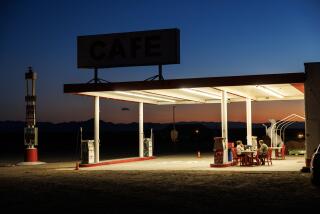Unromantic Side of Route 66
Route 66 may be the most famous road that remains not fully known. Once dubbed âAmericaâs Main Streetâ in hundreds of novels, pop songs, Depression-era dust ballads and even a 1960s TV show, Route 66 was immortalized as the ultimate American icon of freedom--the open road where singer-songwriter Bobby Troup urged us to âget your kicks.â But behind the myth lies an overlooked past of segregation and connectedness, of collective resistance to change and adaptation, as radio documentarian David Dunaway presents in âAcross the Tracks: A Route 66 Story,â which KCRW-FM (89.9) will feature as part of its Labor Day programming specials Monday.
Having spent 21/2 years researching the now 75-year-old stretch of concrete, Dunaway--also a University of New Mexico professor--uses the stories of roadside residents and towns to explore these tensions.
âThe many communities of Route 66 that donât fit into this dominant image of the road that we have--of two guys in a Corvette tearing about--have been sidestepped in our rush to make 66 the perfect incarnation of times past,â Dunaway noted.
âIf people take a different way of looking at the road and see beyond the patina of nifty old cars and collective nostalgia for âOur Town,â they will see the many people displaced by the road or left standing behind the dust of all the travelers who passed.â
The voices of those âleft standingâ are among the more than 70 interviews and songs that color the three-part broadcast. Beginning with the history of the road--from its origins as a trail and then a network of railroad lines--the programâs first hour picks up speed at its end, with a profile of the town of Williams, Ariz.
Although the Interstate Highway Act of 1955 mandated that the historic road be bypassed by thruways, until 1984, Williams--a roadside blip that consisted of little more than a main street--had remained the last stretch of Route 66 interstate-free.
âThe trucks had to use their brakes to get through town since it was the last stoplight between Chicago and Los Angeles,â Dunaway recalled.
âThese giant trucks were rumbling constantly through, and though roadside businesses depended on them, it also became impossible to cross the street.â
When the bulldozers came in, the townspeople were up in arms, blocking construction and employing legal channels to try save the last five miles of Route 66.
âWho knew that there were people so opposed to the closing of Route 66 that they were willing to shoot guns at people trying to build an interstate?â Dunaway said. âThat level of resistance is almost unfathomable to us today.â
The Williams story and dozens like it show how those living along the route relied on Route 66 not just commercially, but also for the sense of connectedness its miles provided to otherwise isolated small prairie and mountain junctions.
With the advent of interstates that paved the way for unencumbered travel, this sense of linkage was lost for tourists too, remembers musician Ry Cooder, a Santa Monica native, whose first two albums were Dust Bowl ballads inspired by the Oklahoma migrants that traveled the route in the 1930s.
âWhen you travel on the interstate, youâre not connected to anything, youâre just flying down this superhighway--you donât see much and you donât feel much,â Cooder said. âIt takes out the experience of traveling the road and the romance of the road.â
But Route 66 was not always dreamy, either.
At the northern end of its path, the road crosses through Times Beach, Mo., where, in the 1950s, a man charged with bringing a tanker of contaminated oil to a waste site unleashed the toxic material on city streets. Even today, descendants of those originally sprayed are born with similar birth defects and neurological problems. âOur country has only one Route 66 park, and ironically, itâs located at possibly the most contaminated small city in America,â noted Dunaway. âThe plume of cancer that has followed Route 66 would surprise and appall many people. Itâs a toxic problem across the tri-state area where it curves from Missouri to Kansas and into Oklahoma.â
And socially, the nostalgia of the roadâs diversity masks a deep segregation that it did not cause, says Dunaway, but to which it remained a âsilent witness.â
One anecdote comes from Hispanic author Rudolfo Anaya, who recalls growing up in Santa Rosa, N.M., where one day he met a group of white tourists passing down the road. Running back to share the experience with his mother, he announces, âMom, when I grow up, I want to be a tourist.â To which she replies, âNo, my hijito , only the Americanos can be tourists.â
A more poignant indication of the price of isolation comes from an African American from Louisiana, who, Dunaway says, had moved with his family to the roadside town of Goffs in the Mojave Desert.
âOn his first trip out on Route 66, he went into a tiny store, where a girl saw him and said, âMommy, is that a [racial slur]?ââ the producer recalled. âAnd the mother of course was terribly embarrassed. But the fact was [the girl] had never seen a person of African descent. Now, how do we react to that?â
Nonetheless, Route 66 served its purpose, which was to tie the nation together as one of the first major highways, Dunaway noted.
âRoute 66 had to end,â Dunaway said, âbecause as our population grew, as our trade grew, we outgrew Route 66, but it took five interstates to replace it--which says a lot about the road.â
*
âAcross the Tracks: A Route 66 Storyâ can be heard Monday from 9 a.m. to noon on KCRW-FM (89.9).
More to Read
Sign up for Essential California
The most important California stories and recommendations in your inbox every morning.
You may occasionally receive promotional content from the Los Angeles Times.










